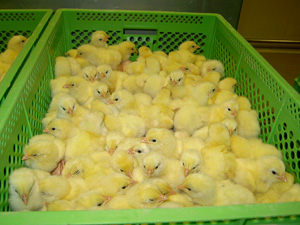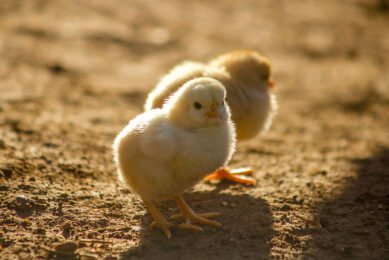Prevent dehydration by body temperature control

Day old chicks are very sensitive to external factors. These change a lot from the moment of hatch and during the first three days of their life post-hatch. Keeping the body temperature permanently between 40 and 40.6 degrees Celsius during this period will prevent dehydration and allows a better start. Permanently measuring body temperature is therefore needed.
By Dr Inge van Roovert-Reijrink, HatchTech, the Netherlands
During the last decades, commercial hatcheries mainly focused on maximum hatchability. However, the quality of the day-old chicks also becomes more and more important. To obtain and maintain maximum chick quality, the environmental conditions after hatch are as crucial as the environmental conditions before hatch. From hatch until arrival at the farm, chickens do not have access to feed and water.
This time period can be up to 72 hours. Reasons for this long time period is the variation in time of hatching; the hatch window, plus time needed for chick handling, storage, and transport to the farm. It is known that withholding of feed and water is detrimental for chick quality. One reason for this effect is the chance that chicks get dehydrated in the period that they do not have access to water. Dehydration caused by excessive water loss, which can be determined by measuring body weight loss, can increase mortality or can negatively affect later performance.
Influencing environmental factors
It is, therefore, important to prevent dehydration of the chickens after hatch. To prevent dehydration, it is important to know which environmental factors influence body weight loss of the chickens. During incubation, relative humidity and eggshell temperature affect egg weight loss. To investigate whether the relative humidity and body temperature also influence body weight loss after hatch, the research department of HatchTech performed an experiment with four treatments:
It is, therefore, important to prevent dehydration of the chickens after hatch. To prevent dehydration, it is important to know which environmental factors influence body weight loss of the chickens. During incubation, relative humidity and eggshell temperature affect egg weight loss. To investigate whether the relative humidity and body temperature also influence body weight loss after hatch, the research department of HatchTech performed an experiment with four treatments:
1. Average body temperature of 40.3°C and a relative humidity of 50%
2. Average body temperature of 40.3°C and a relative humidity of 35%
3. Average body temperature of 41.5°C and a relative humidity of 50%
4. Average body temperature of 41.5°C and a relative humidity of 35%.
The treatments were administered during the last 22 hours in the hatcher. This is the period that the chicks that hatched early during the hatch window stay in the hatcher until the last chick hatched.
Twenty-two hours before pull time, the body weight of 50 dried Cobb-500 chickens was measured. At pull time, the body weight of the same chickens was measured again to calculate body weight loss during 22 hours in the hatcher. Body temperatures where determined by measuring rectal temperatures two hours after the start of the treatments and just before pull time.
Temperature is crucial
In Figure 1, it is shown that the largest body weight loss was found in the two treatments in which the average body temperature was 41.5°C. The difference in body weight loss between the average body temperature of 40.3°C and 41.5°C was approximately 2.5 grams. Relative humidity did not influence body weight loss.
In Figure 1, it is shown that the largest body weight loss was found in the two treatments in which the average body temperature was 41.5°C. The difference in body weight loss between the average body temperature of 40.3°C and 41.5°C was approximately 2.5 grams. Relative humidity did not influence body weight loss.
These results clearly show that relative humidity does not affect body weight loss of chickens, but that body temperature control is crucial to prevent excessive water loss and therefore dehydration of chickens between hatch and arrival at the farm. To prevent dehydration of chickens the body temperature should be checked regularly in the hatcher, during chick handling, storage, and transport and should be maintained between 40 and 40.6°C.
When the body temperatures are maintained between these temperatures, the time between hatch and arrival at the farm becomes less important because dehydration is prevented.
Why is body temperature control crucial to prevent dehydration? Chickens are able to remove body heat by sensible and latent heat loss. Sensible heat loss is removal of heat by conduction, radiation, and convection. Latent heat loss is removal of heat by evaporation of water. If the body temperature of chickens increases above 40.6°C they experience heat stress and start panting to increase their latent heat loss. This increases the water loss from the body and increases the risk for dehydration. Chickens under heat stress will lose 5 to 10 grams of water in 24 hours. To prevent dehydration and to maintain chick quality after hatch, it is crucial to maintain body temperatures between 40 and 40.6°C. |













